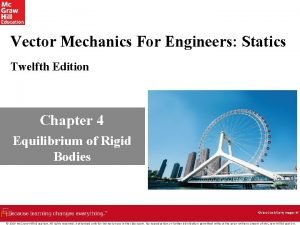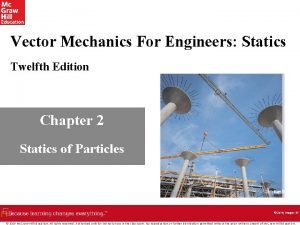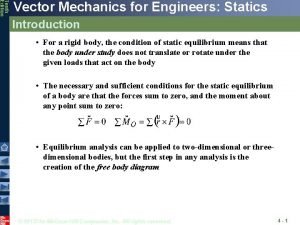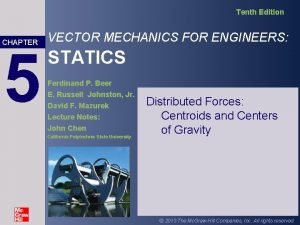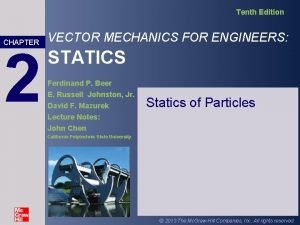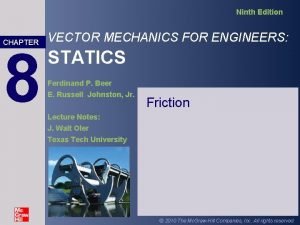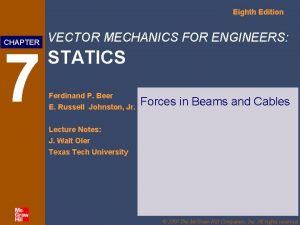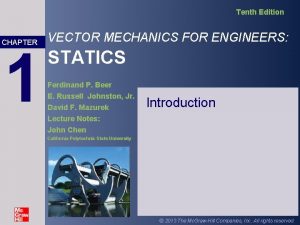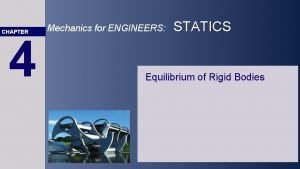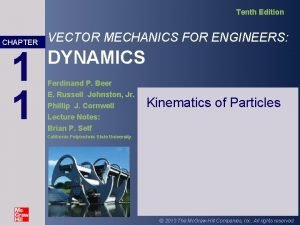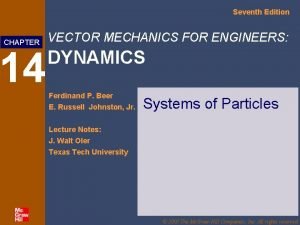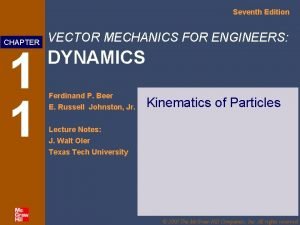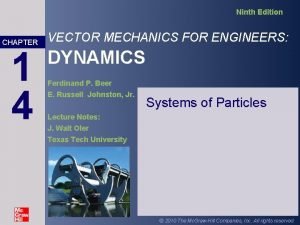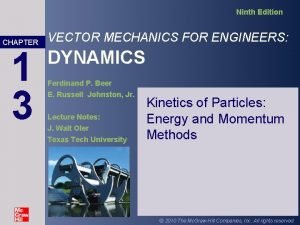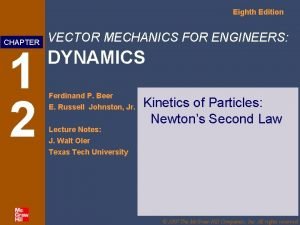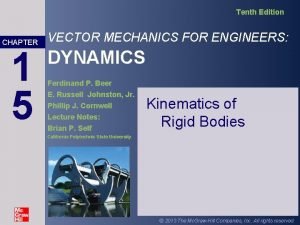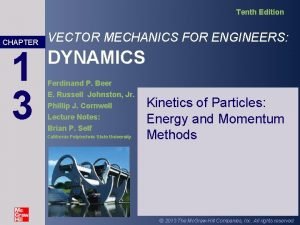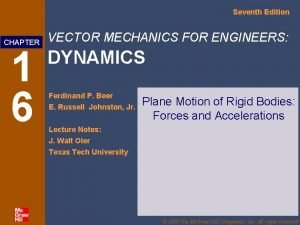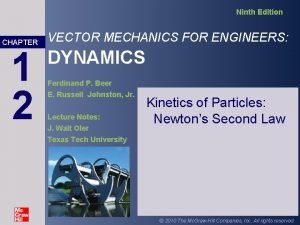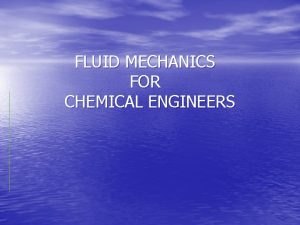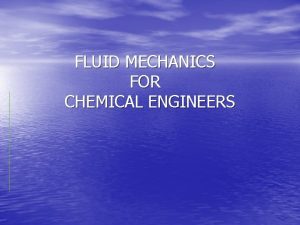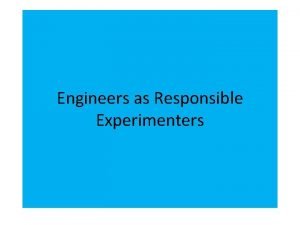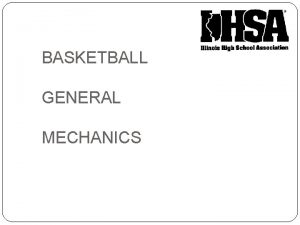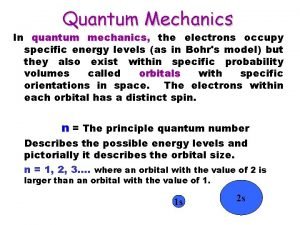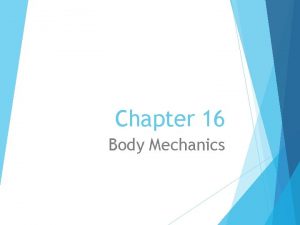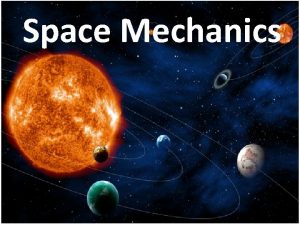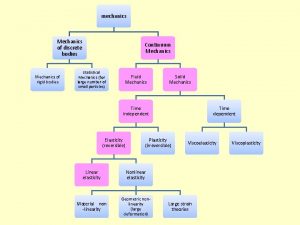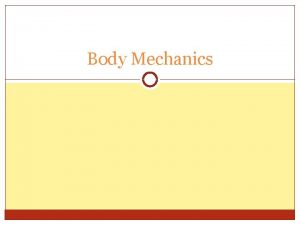Mechanics for Chemical Engineers II 201819 Outline n


































- Slides: 34

Mechanics for Chemical Engineers II 2018/19

Outline n n n Transportation of fluids Heat engines Electric motors

Transportation of fluids n n Fluids: A fluid is defined as a substance that continually deforms (flows) under an applied shear stress regardless of how small the applied stress (liquid, gas, vapor). Chemical equipments usually work with fluids The quantitative description of unit operations based on the space and time dependence of fluids. The motion laws of liquids and gases are very similar

Fluid mechanics Newton’s second law for fluids: Navier-Stokes equation

Fluid statics or hydrostatics is the branch of fluid mechanics that studies incompressible fluids at rest. Hydrostatic pressure:

Pascal's law: A change in pressure at any point in an enclosed fluid at rest is transmitted undiminished to all points in the fluid. Pascal's barrel A hydrostatics experiment allegedly performed by Blaise Pascal in 1646. When water was poured into the vertical tube, Pascal found that the increase in hydrostatic pressure caused the barrel to burst.

Utilization of Pascal ‘s law: When wide connected tubes are filled with liquid, the liquid rises to the same level in all, if above the liquid surfaces the pressure are the same. a, Only one kind of liquid Communicating vessels

b, Different liquids:

c, Different air pressure (U tube manometer): The difference in fluid height in a liquid column manometer is proportional to the pressure difference. For measurement of gas pressure differences

Industrial utilization: Liquid level measurement

Hydraulic lift: Pascal's Principle Pressure is transmitted undiminished in an enclosed static fluid.

Fluid mechanics Newton’s second law for fluids: Navier-Stokes equation Stationary, incompressible flow, no inner friction: Mechanical energy balance: Bernoulli-equation Energy conservation along a streamline. constant at every point in a streamline.

Continuity equation


Bernoulli’s principle If h 1 = h 2 then An increase in the speed of the fluid occurs simultaneously with a decrease in pressure.

Bernoulli’s principle

Example 1

Flow measurement –Venturi meter

Flow measurement – Pitot tube

Flow measurement – Pitot tube

Flow measurement – Pitot tube

Head Bernoulli-equation – „height form” Head is a concept that relates the energy in a fluid to the height of an equivalent static column of that fluid.

Flow of fluids Laminar flow (streamline flow) A fluid flows in parallel layers, with no disruption between the layers. Velocity independent from time. The Reynolds number can be used to characterize different flow regimes. Laminar: Re < 2000

Turbulent flow In fluid dynamics, turbulence or turbulent flow is a flow regime characterized by chaotic, stochastic property changes with rapid variation of pressure and velocity in space and time. High energy loss. Turbulent flow: Re > 4000 Transitional flow: 2000 < Re < 4000.


Pipe and tubing Fluids are usually transported in pipe or tubing. There is no clear-cut distinction between the terms pipe and tubing. Generally: Pipe: heavy-walled, relatively large in diameter, moderate length (6, 12 m) Tubing: thin-walled, comes in coils several hundred m long. Metallic pipe can be threaded tubing usually cannot. Pipe walls are usually slightly rough, tubing has very smooth walls.

Pipe and tubing are made from many material: metals, alloys, wood, ceramics, glass and various plastics. PVC is extensively used (wastewater pipes) Regardless of wall thickness, the outside diameter of all pipes of a given nominal size is the same, to ensure interchangeability of fittings. The wall thickness of pipe is indicated by the schedule number, which increases with the thickness.


Selection of pipe sizes Depends on the cost of the pipe and fittings and the cost of energy needed for pumping the fluid. The cost of the pipe increases with about the 1. 5 power of the diameter. The power cost for turbulent flow varies with the -4. 8 power of the diameter. Equations for optimum pipe diameter as a function of flow rate and fluid density. These can be converted to the optimum velocity. For water: Vopt=1 -2 m/s For air or steam: Vopt=6 -24 m/s

Optimal pipe diameter: Small diameter → cheap pipe great flow velocity, high energy need (turbulent) E – energy cost (transporting cost) A – amortization (investment) + repair

Pressure drop and friction losses in a pipe In real systems energy (pressure) loss arises due to friction. When a fluid flows through a pipe the internal roughness of the pipe wall can create local eddy currents within the fluid adding a resistance to flow of the fluid. Pipes with smooth walls such as glass, copper, brass and polyethylene have only a small effect on the frictional resistance. Pipes with less smooth walls such as concrete, cast iron and steel will create larger eddy currents which will sometimes have a significant effect on the frictional resistance.

Pressure (energy) loss of streaming fluids: Conservation of energy: Bernoulli-equation In real systems energy loss arises due to friction

The friction force is proportional with the surface and the kinetic energy in a volume (dynamic pressure): where f : friction factor d : pipe diameter l : pipe length This force can be expressed by the pressure difference: Expressing DP the Fanning equation has got: f : Fanning friction factor Or the Darcy–Weisbach equation: f : Darcy friction factor (or l)

The Fanning friction factor is one-fourth of the Darcy friction factor. Attention must be paid to note which one of these is meant in the "friction factor" chart or equation consulted. Laminar flow: Turbulent flow: it depends on the pipe roughness too (Moody chart)
 Fanning egyenlet
Fanning egyenlet Schöppenstedt formula
Schöppenstedt formula Vector mechanics for engineers statics 12th
Vector mechanics for engineers statics 12th What is line of action
What is line of action Mechanics
Mechanics Vector mechanics for engineers
Vector mechanics for engineers Mechanics for engineers
Mechanics for engineers Static mechanics
Static mechanics Vector mechanics for engineers
Vector mechanics for engineers Vector mechanics for engineers 10th edition
Vector mechanics for engineers 10th edition Rocker statics
Rocker statics Vector mechanics for engineers: dynamics
Vector mechanics for engineers: dynamics Vector mechanics for engineers: dynamics
Vector mechanics for engineers: dynamics Vector mechanics for engineers dynamics 12th
Vector mechanics for engineers dynamics 12th Vector mechanics for engineers: dynamics
Vector mechanics for engineers: dynamics Vector mechanics for engineers: dynamics
Vector mechanics for engineers: dynamics Vector mechanics for engineers: dynamics
Vector mechanics for engineers: dynamics Vector mechanics for engineers statics 10th edition
Vector mechanics for engineers statics 10th edition Vector mechanics for engineers dynamics 12th
Vector mechanics for engineers dynamics 12th Vector mechanics for engineers dynamics 12th
Vector mechanics for engineers dynamics 12th Vector mechanics for engineers dynamics 12th
Vector mechanics for engineers dynamics 12th Vector mechanics for engineers dynamics 12th
Vector mechanics for engineers dynamics 12th Aiche code of ethics
Aiche code of ethics Quotation sandwiches
Quotation sandwiches Fspos
Fspos Typiska novell drag
Typiska novell drag Tack för att ni lyssnade bild
Tack för att ni lyssnade bild Ekologiskt fotavtryck
Ekologiskt fotavtryck Shingelfrisyren
Shingelfrisyren En lathund för arbete med kontinuitetshantering
En lathund för arbete med kontinuitetshantering Adressändring ideell förening
Adressändring ideell förening Tidböcker
Tidböcker Anatomi organ reproduksi
Anatomi organ reproduksi Förklara densitet för barn
Förklara densitet för barn Datorkunskap för nybörjare
Datorkunskap för nybörjare


